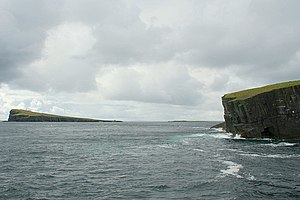Copinsay
| Copinsay | |
|---|---|
| View of Copinsay from the south. On the right the "horse of Copinsay" | |
| Waters | North Sea |
| Archipelago | Orkney Islands |
| Geographical location | 58 ° 54 ′ 0 ″ N , 2 ° 40 ′ 0 ″ W |
| length | 1.6 km |
| width | 730 m |
| surface | 73 ha |
| Highest elevation | Broad Lee 70 m |
| Residents | uninhabited |
Copinsay (from Old Norse "Kolbeinsey" = German " Kolbein Hrúgas Island") is a small, triply articulated, uninhabited island of the Orkney , which is about 5.5 km from Deerness , the eastern peninsula of Mainland .
Characteristic
Copinsay and the associated small Holme (Corn, Black and Ward Holm) are part of a nature reserve (RSPB Reserve) that was acquired by the RSPB in 1972 . The spars are on the west side and are tidal islands that can be reached on foot from Copinsay when the tide is low.
The "horse of Copinsay" is a steep rock in the sea off the northeast side of the island. The approximately 28.0 meter high rock has a blowhole at the northern end, which is noticeable in rough weather when the spray becomes visible. Because of the strong swell , the "horse" is difficult to reach.
The island was inhabited until 1958, when the last residents moved to Mainland. Today a school building, two farms and stables and a street are still visible. The island must have been inhabited since early history, as an old burial place and a rubbish heap were found.
Today, some fields are not appointed at the request of the RSPB to the corncrake to provide habitat.
In 1774 G. Low described the chapel of Corn Holm (Kirkholm) as a building with a width of 4.6 m, a wall thickness of 1.5 m and a very low door.
fauna
seals
There is a larger colony of gray seals of around 2000 animals on the island , which regularly give birth to their young there in November.
Birds
The wedge-shaped Scottish island has a long 70 meter high cliff on the east side, which is the preferred breeding ground for sea birds. Kittiwakes , guillemots , fulmars , puffins , razorbills and black guillemots breed on the island and the Holmen . There is the rare corn corn in the grass below the cliffs. Also shags , rock pigeons , crows , eider ducks and Arctic terns nest here. Peregrine falcons also existed in the past . Copinsay is particularly popular in early summer when the birds nest and the plants are in bloom. On the “horse” there are colonies of seagulls , gannets and cormorants .
Overall, the island is regularly used by around 70,000 seabirds in the breeding season.
lighthouse
In 1915, the now automated lighthouse towering 79 meters above water level (architects: David Alan Stevenson and Charles Alexander Stevenson ) was completed on the island, which went into operation after the First World War and completed the lighting on the eastern side of the Orkney.
literature
- Hamish Haswell-Smith: The Scottish Islands. Canongate, Edinburgh 2004, ISBN 0-86241-579-9 .
Web links
- Entry on Copinsay in Canmore, Historic Environment Scotland's database


